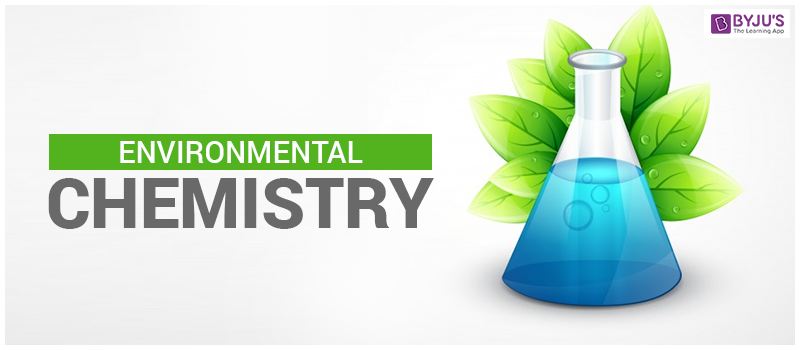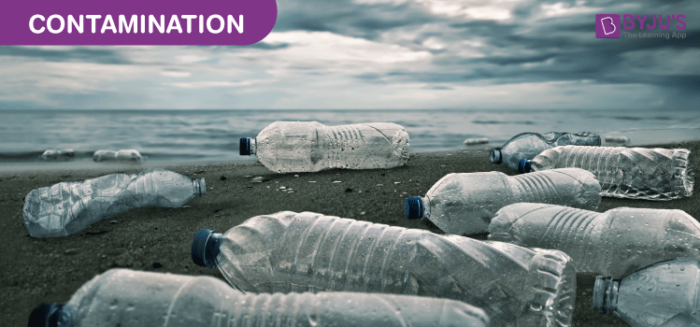What is Environmental Chemistry?
Earth is composed of numerous minute substances and particles which are involved in reactions leading to the formation of new ones. Hence, the earth is said to be a closed system and the energy comes and leaves the planet, of which most of the mass stays here. This means that all the elements on this planet are continuously recycled within the environment.
For example, consider free oxygen molecules that were floating in the atmosphere yesterday and it might be the part of someone’s hamburger the next day. It’s all up to the chemists to study these cycles and watch their movements.
Table of Content
- Definition of Environmental Chemistry
- Recommended Videos on Environmental Chemistry
- Environmental Chemistry Facts
- What is Contamination?
- Applications of Environmental Chemistry
- FAQs
Definition of Environmental Chemistry
Environmental Chemistry can be defined as:
The field of chemistry deals with the study of reactions, sources, transport, and effects, along with the fates of all the chemical species present in the soil, water, and air environments, and also the effects of technology thereon.

- Environmental chemistry is the scientific study of the biochemical and chemical phenomena that occur in natural places.
- Environmental chemistry is a study that is more than air, water, soil, and chemicals. This field uses various techniques of biology, maths, genetics, engineering, hydrology, toxicology, etc. that will help to fetch an answer to all the questions related to the environment.
- Environmental chemistry also contains aspects of analytical chemistry, physical chemistry, organic chemistry & inorganic chemistry as well as more diverse areas, such as epidemiology, public health, biochemistry, biology, & toxicology.
- Environmental chemists are responsible for finding how the unpolluted environment functions and finding ways of sustainable development which do not harm the environment.
Recommended Videos

Environmental Chemistry Facts
Aluminium can be continually recycled, as in forever. Recycling 1 aluminium can save enough energy to run at least three hours of our TVs. Every year 80 trillion cans of aluminium are used by humans.
The chemical industry is usually associated with fluxes of polluted waste. There are, however, many other sources of water chemical pollution, including transport, agriculture, power plants and household chemicals like detergents. In fact, the chemical industry’s waste streams are now strictly controlled and treated before they are released into the environment.
Chemical weathering means a chemical transformation or degradation, which usually occurs when the chemical is released into the environment. In the air, weathering is due to a combination of processes that all results in reducing the air concentration of pollutants.
Chemical water contamination can cause severe long-term problems. The consequences of acute chemical emissions on air, however, are typically short-term-but they may still be devastating.
Read More:
What is Contamination?
Contamination of the environment takes place when there are unwanted chemical substances present in the atmosphere. In fact, environmental chemistry mainly deals with the study of these unwanted substances and their effects.

Some contaminants of the environment are mentioned below.
- Small contaminants: Small contaminants are those metal particles that can be easily measured and controlled. These particulate contaminants can be monitored by the process of abrasion, fatigue and silting.
- Chemical Contaminants: These are the pollutants that are produced by the process of chemical reactions. They contaminate the water and soil, and those are arsenic, nitrate, fluoride, manganese atom, iron, etc.
- Gaseous contamination: This type of pollution occurs through pollution of the gaseous atmosphere by the components such as sulphur, chlorine, bromine, etc.
- Microbial contamination: This is known to be one of the dangerous types of contamination as it does not only affect the environment but also the living system within it. The cause for this is microbes such as yeast, bacteria, mould, fungi, protozoa, viruses, or toxins and by-products.
Applications of Environmental Chemistry
Some applications of environmental chemistry are mentioned below.
- Environmental Chemistry studies the risk factors of all the chemicals in-depth to get a solution for the safety purpose of the environment.
- It is applied in the study of new products and their effects on the environment.
- Environmental Chemistry is used in the method of protecting groundwater which is polluted by soil, dust, and waste particles.
- It is useful for the protection of surface water from contaminants through the process of sedimentation, bacteriological, and radiation.
- The quality of the soil is protected by the methods of environmental chemicals such as by the use of indicators like ecotoxicological and chemical.
- Impervious surfaces inside cities like parking lots, rooftops & roads are prone to build up unwanted pollutants such as motor oil, gasoline, nutrients and sediment (soil), hydrocarbon compounds, and metals.
- Environmental chemistry is applied in Waste Management and Cleaner Production.
Frequently Asked Questions – FAQs
How does chemistry help the environment?
Chemistry will help us understand the world around us, track it, protect it and develop it. Chemists are designing tools and techniques to ensure that air and water contamination is seen and measured.
Why is chemistry important to the environment?
Environmental chemistry is socially important as it deals with pollutants ‘ environmental impact, contamination reduction, and environmental management.
What is environmental protection?
Environmental protection is the task of people, organizations, and governments to protect the natural environment. The biophysical ecosystem is degraded, often permanently, due to the pressures of overconsumption, population growth, and innovation.
How does Green Chemistry help the environment?
Green chemistry eliminates the source of pollution by reducing or removing the risks of chemical feedstocks, reagents, solvents, and materials. Its innovation would count as a green chemistry technology if a system reduces or removes the hazardous chemicals used to clean up environmental pollutants.
What are the 5 major environmental problems?
Pollution is one of many other environmental issues ‘ primary causes, including climate change and biodiversity. All 7 main pollution forms-air, water, soil, noise, radioactive, light, and thermal-affect our atmosphere.
What is environmental chemistry used for?
Environmental chemists are researching how pollutants pass through the environment-usually toxins. This is alluded to as the “fate and transportation” of chemicals. They also research the impact on wildlife, livestock, and human health of these toxins.
How is chemistry used in daily life?
Chemistry is a huge part of our daily lives. Chemistry is where we spend the day. In the foods we consume, the air we drink, cleaning substances, our feelings and practically any item that we can see or touch, one can find chemistry in everyday life. Our body is composed of chemical compounds which are ingredient combinations.
What is the main goal of environmental science?
One of environmental science’s key objectives is to consider and address environmental issues. Scientists are studying two major forms of relations between humans and their world in order to achieve this purpose. One focus field is how we use natural resources, such as water and plants.
Stay tuned with BYJU’S to learn more interesting topics in Chemistry. Also, get various engaging and video lessons to learn more effectively.

very helpful infomation
very useful